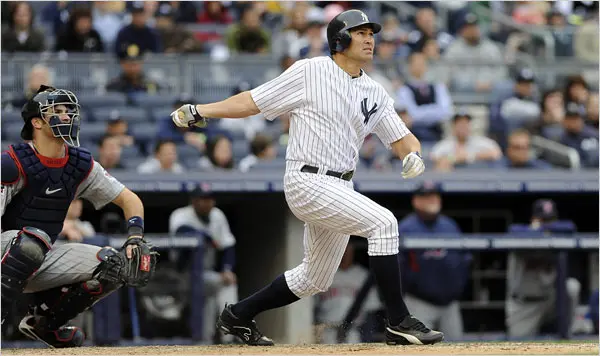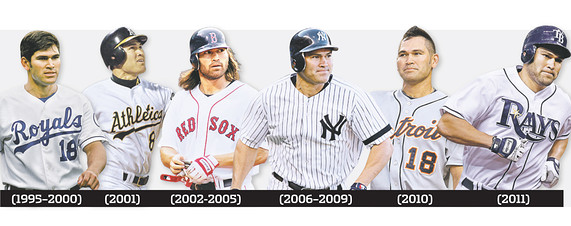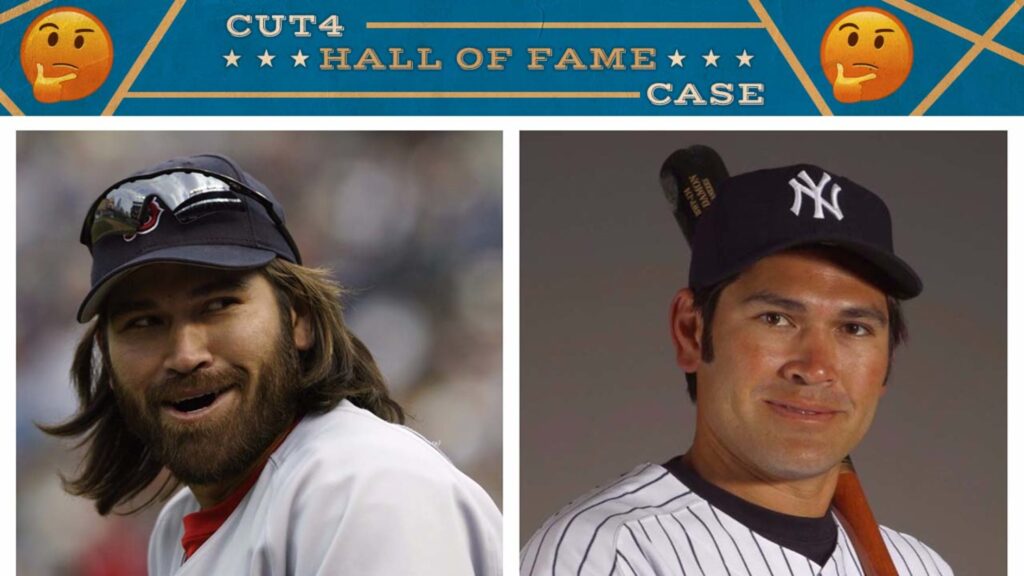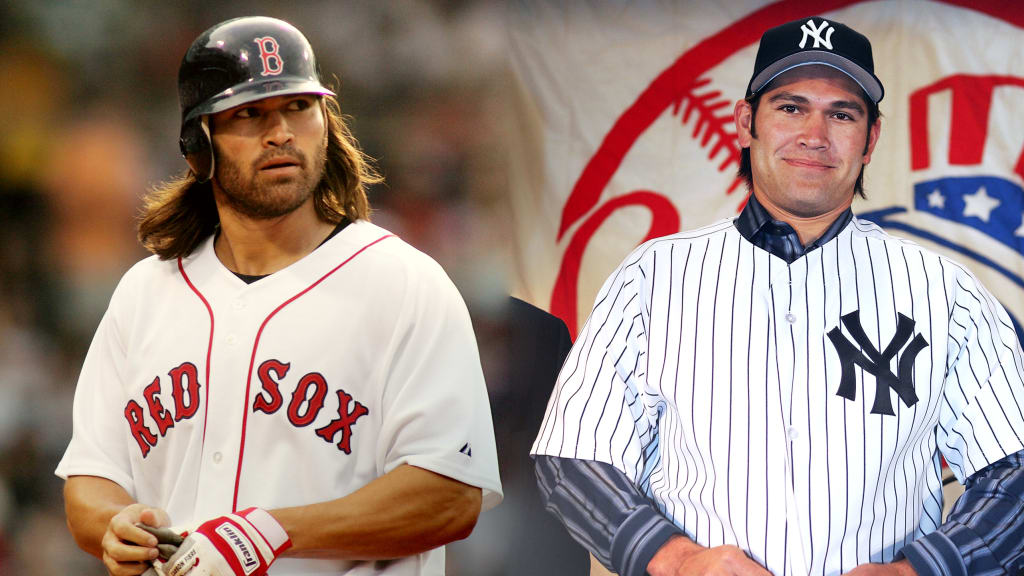A force of nature with a mane of wild hair, a brave smile and legs designed for clutch crimes, Johnny Damon was more than just another ballplayer when he took the pitch.

Johnny Damon’s fearless base-running and clutch playoff moments made him a fan favorite in Boston and New York. In a way, his knack for delivering under pressure reminds me of Cal Raleigh’s recent postseason heroics for the Mariners, a story I’ve covered in detail here.
He never shied away from taking the additional stride that may alter the outcome, running the bases like a man on a mission. However, Damon’s repute extends well beyond his quickness or boldness. He broke the “Curse of the Bambino,” which plagued the Boston Red Sox for 86 long years, and helped lead the team to one of the most memorable comebacks in sports history in 2004. He was more than simply a leadoff hitter to Red Sox supporters; he was the inspiration, the devotion, and the determination that made history out of hope.

Early Life & Career Start
Born on November 5, 1973, in Fort Riley, Kansas, Johnny David Damon lived up in a military family members, consequently moving was a common affair. Baseball was more than simply an activity for him from an early age; it was his language, his escape, and his goal all intertwined. Damon struggled with a speech impairment as a child, but when he on the field, his voice was his bat, and line drives and stolen bases told the story of his life.
He established himself at Dr. Phillips High School in Orlando, Florida, where scouts from all over the country were drawn to his lightning-fast rate and hitting prowess. When he got picked by the Kansas City Royals in the first round of the 1992 Major League Baseball draft, his ambition came true. Damon made his Major League debut with the Royals in 1995, barely four years later, immediately established himself as a game-changer rather than merely a talented rookie. His constant work ethic, ability to reach base, and talent for converting singles into doubles set the stage for a rewarding future career.
Rise to Fame
By the late 1990s, Johnny Damon had developed into one of baseball’s most powerful leadoff hitters, not just the quick Kansas kid. In 2001, after years of honing his craft with the Kansas City Royals, Damon brought his skills to the Oakland Athletics, where his enthusiasm and reliability kept him in the media’s eye. However, it was that move to Boston in 2002 that made him a household name.

Damon became not merely just a baseball player in Boston; he was a symbol. He was a fan favourite because of his daring base running, clutch at-bats, and the knack to alter the course of a game with a single swing. Then there was the appearance—the unkempt beard, the flowing hair—which was all Red Sox and half rock star and irreverent.
He brought a new kind of swagger to Fenway Park, the kind that told fans, we’re here to win, and we’re going to have fun doing it.Over the next few years, Damon would etch his name into Red Sox lore, not just with his bat and glove, but with an unshakable determination that made him the spark plug of one of baseball’s most iconic teams.
For 86 long years, Boston Red Sox fans carried a weight—the so-called “Curse of the Bambino”—a decades-old legend born from the sale of Babe Ruth to the Yankees in 1919. Year after year, hope would rise and heartbreak would follow. But in 2004, everything changed, and Johnny Damon was right in the middle of it.
The 2004 Red Sox & The Curse Break
That postseason, the Red Sox found themselves in a nightmare—down 0–3 to the New York Yankees in the ALCS. No team in MLB history had ever come back from that deficit. But Damon and his teammates weren’t interested in history as it was written—they wanted to rewrite it. Game after game, Boston clawed their way back, with Damon delivering one of the most unforgettable moments in Game 7: a towering grand slam that sent Fenway Faithful into a frenzy.
By the time the dust settled, the Red Sox had not only beaten their archrivals, they had gone on to sweep the St. Louis Cardinals in the World Series, breaking the curse once and for all. For fans, Damon wasn’t just the guy with the wild hair and the quick feet—he was a hero who helped lift an 86-year shadow from the city.
Damon’s powerful grand slam in Game 7 hurled the Fenway faithful into a frenzy, one of the most significant events after Boston clawed their way back game after game.
Once all was done and dusted, the Red Sox had not only vanquished their bitter rivals but also swept the St. Louis Cardinals in the World Series, ending the curse for good. Fans saw Damon as a hero who helped lift an 86-year-old shadow from the city, not simply the guy with the wild hair and the lightning-fast feet.
Controversial Move to the Yankees
In Boston, Johnny Damon was more than a player—he was part of the family. He’d helped break the curse, delivered clutch hits, and played with a fearless style fans adored. That’s why, when the news broke in December 2005 that Damon had signed a four-year deal with the New York Yankees, Red Sox Nation felt like it had been hit with a fastball to the gut.
The move wasn’t just a change of uniforms—it was a leap across one of the fiercest rivalries in sports. For many Boston fans, seeing Damon shave his signature hair and beard to meet the Yankees’ clean-cut policy felt like losing the rebellious hero they’d cheered for. In New York, however, he quickly proved his worth. Damon brought the same hustle, clutch hitting, and veteran leadership, helping the Yankees stay competitive and eventually win the 2009 World Series.
It was a move that cemented Damon’s place in baseball history—not just as a Red Sox legend, but as one of the rare players to be embraced by both sides of the game’s most heated rivalry. Still, for some Boston fans, the sting of that switch never truly faded.
Later Career & Retirement
Johnny Damon’s baseball life took a little turn after he left the Yankees. He brought his signature effort and experienced knowledge to the Tigers’ clubhouse after he packed his bags to move to Detroit in 2010. After a year, the Rays moved to Tampa Bay, where his experience and leadership contributed to pushing them into the postseason.
Damon didn’t go calmly into retirement when his 18-year MLB era came to an end. By getting involved with shows like Dancing with the Stars and Celebrity Apprentice, he switched stadium lights for TV spotlights, allowing fans to observe the jolly, competitive side they had always believed was there. Making just as much of an impact off the pitch as he did on it, he dedicated his time and energy to give back off-camera by sponsoring youth sports, veterans’ companies, and children’s hospitals.
Today, Johnny Damon still carries that spark. Whether he’s at a Red Sox reunion, chatting with fans, or sharing stories about “the curse” and that famous grand slam, you can tell baseball never really left him. The uniform might be in the closet, but the passion? That’s forever.
Legacy & Impact
Johnny Damon’s career wasn’t just about the numbers—though 2,769 hits, 408 stolen bases, and two World Series rings are nothing to sneeze at. It was about the way he played the game. Every at-bat, every dash to first, every daring steal was fueled by an unshakable belief that effort could change the outcome. Fans didn’t just watch Damon; they felt his energy.
In Boston, he’ll forever be remembered as the spark who helped shatter an 86-year-old curse. In New York, he’s the steady hand who delivered in the biggest moments, proving that baseball loyalty is sometimes more complex than rivalries. And across the league, he’s respected as the rare player who left it all on the field—every single game.
Fans are going to cherish Damon’s greatest legacy—the wild hair flying as he walks the bases, the daring slides into second, and his beaming face after a big play—but his generosity and charm have kept him in the spotlight off the diamond. Apart from being an excellent player, Johnny Damon served as a reminder that baseball is best played with enthusiasm, hustle, and a dash of pride.
FAQs
Q1: How many bases did Johnny Damon steal in his career?
Johnny Damon stole 408 bases over his 18-season MLB career, making him one of the most reliable and aggressive base runners of his era.
Q2: What made Johnny Damon such a great base stealer?
Damon combined natural speed with excellent instincts. He read pitchers well, timed his jumps perfectly, and wasn’t afraid to take risks when it mattered most.
Q3: Was Johnny Damon more than just a base stealer?
Absolutely. While his speed was legendary, Damon was also a consistent hitter, strong defender, and a clutch performer in high-pressure games.
Q4: What does “stole hearts” mean in the title?
It’s a playful nod to his charisma and popularity. From his wild hair days in Boston to his clean-cut Yankees look, Damon’s energy, personality, and big-game performances won over fans across the country.
Q5: Did Johnny Damon play for both the Red Sox and Yankees?
Yes—and that’s part of what makes his career so memorable. He was a key figure in breaking the Red Sox’s “Curse of the Bambino” in 2004, then later won another World Series with the Yankees in 2009.
Q6: What was Damon’s most famous stolen base moment?
One of his most memorable steals came in Game 4 of the 2004 ALCS against the Yankees, part of Boston’s historic comeback from a 0–3 series deficit. His speed and smarts changed the momentum of the series.

Pingback: How Kate Middleton Became a Global Style Icon: A Powerful Story - statesgazette